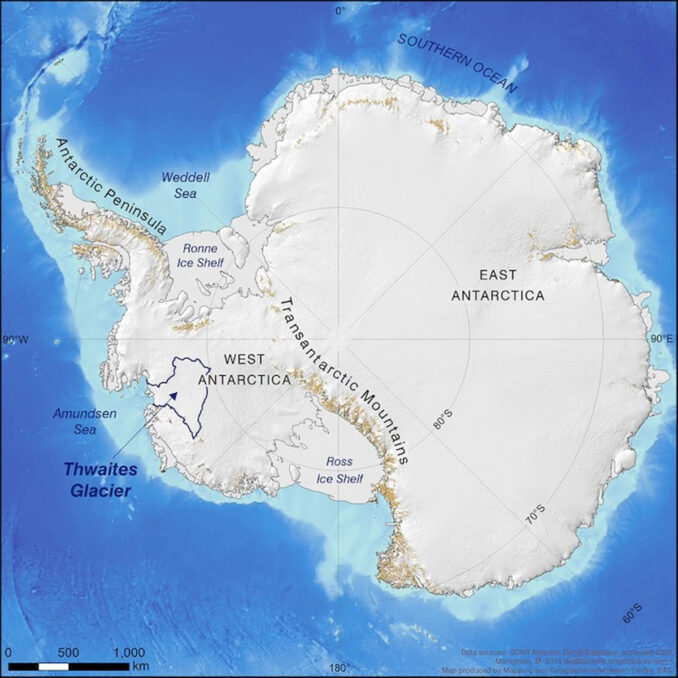Climate change has the potential to unleash enormous and lethal tsunamis in Antarctica, with far-reaching consequences globally, according to a recent study. The research indicates that such catastrophic events have occurred in the past when temperatures in Antarctica were up to 3 degrees Celsius warmer than they are today.
As the region continues to experience rising temperatures, breaking records along the way, scientists are sounding the alarm about the renewed possibility of massive tsunamis. These findings emerged from a comprehensive study aimed at uncovering the causes behind gigantic underwater landslides in Antarctica.
A team of researchers from the University of Plymouth made a groundbreaking discovery during their investigation. They identified layers of fossilized sediments, rich in biological material, lying beneath the sea floor. These sediment layers, situated a hundred meters below the ocean’s surface, exist beneath extensive areas affected by underwater landslides.
Published in the journal Nature Communications, the study highlights the previously unknown submarine landslide-generated tsunami risk that Antarctica’s continental margins pose to populations and infrastructure in the Southern Hemisphere. Jan Sverre Laberg from The Arctic University of Norway, Tromso, emphasized the relevance of gaining further knowledge about these events in Antarctica, as it would aid in the evaluation of submarine geohazards off the coast of Norway.

The discovery of these landslides took place during the Italian ODYSSEA expedition in the eastern Ross Sea back in 2017. An international team of scientists made the groundbreaking observation. It was found that the newly identified weak layers, composed of historic biological material, rendered the area highly susceptible to failure when subjected to seismic activity and earthquakes.
The study reveals that the massive tsunamis were triggered during a period when temperatures in Antarctica were up to 3 degrees Celsius warmer than they are presently. This era experienced higher sea levels and smaller ice sheets compared to the present conditions.
The University of Plymouth, in a press release, stated, “With the planet currently undergoing a period of extensive climate change – once again including warmer waters, rising sea levels, and shrinking ice sheets – there is the potential for such incidents to be replicated.”
The implications of these findings are alarming. Climate change is transforming Antarctica’s environment, leading to the melting of ice and increasing sea temperatures. These changes create a precarious situation where significant sections of the ice shelves could become unstable, triggering large-scale underwater landslides and subsequent tsunamis.

The potential consequences of these tsunamis extend far beyond Antarctica. Due to the interconnectedness of the Earth’s oceans, the impact of such events could be felt worldwide. Tsunamis generated in Antarctica have the potential to travel across vast distances, reaching distant coastlines and causing widespread devastation.
The threat to coastal populations and infrastructure in the Southern Hemisphere is particularly concerning. Many regions in this part of the world are densely populated and vulnerable to the effects of rising sea levels and extreme weather events. Understanding and preparing for the risk of submarine landslide-generated tsunamis is crucial for safeguarding lives and minimizing potential damage.
Efforts to address climate change and mitigate its effects are more critical than ever. The findings of this study serve as a stark reminder of the urgent need to reduce greenhouse gas emissions, curb global warming, and preserve the delicate balance of our planet’s ecosystems.
Moreover, further research and monitoring of Antarctica’s continental margins are necessary to enhance our understanding of these events. Collaborative scientific endeavors, like the ODYSSEA expedition, contribute to our knowledge of Antarctica’s unique environment and its complex interactions with the changing climate.
In conclusion, the study’s findings highlight the potential for gigantic and deadly tsunamis in Antarctica due to climate change. The discovery of fossilized sediments and weak layers beneath the sea floor reveals the historical occurrence of these events during periods of warmer temperatures. With the current state of extensive climate change, characterized by rising sea levels and shrinking ice sheets, the risk of such tsunamis resurfacing is a cause for concern. Adequate measures to mitigate climate change and increased research efforts are crucial to ensure the safety of coastal populations and infrastructure worldwide.













